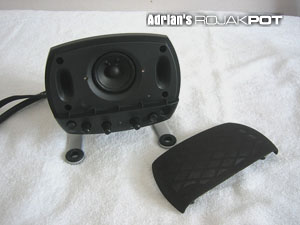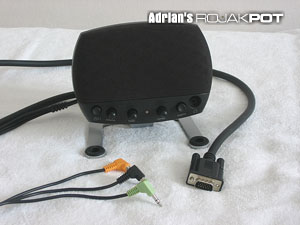Center Speaker
The center speaker comes in at roughly 14cm x 13cm x 10cm, including its stand.
The center speaker's stand can also be rotated. This allows you to either put it on your monitor or on the table, in front of your monitor.
To place the center speaker on your monitor, all you need to do is rotate the stand with both of its rubber pads pointing towards the back. There is no way you can mount the center speaker on the wall, unless you mod the stand.
The center speaker is also magnetically-shielded, so you don't have to worry placing it near your monitor.
Removing the center speaker's grill reveals the speaker inside.
I'm not very surprised to see that the center speaker is actually using the same full range driver used in the satellite speakers. IMHO, it's acceptable at this price range. Logitech has to find some way to cut the cost.
The center speaker has three plugs and a 15-pin VGA connector coming out the back.
The plugs are colour-coded, which is necessary. The green plug goes to the front channel, the black plug goes to the rear channel and the orange plug goes to the center/subwoofer channel of your sound card. The VGA connector, on the other hand, goes to the subwoofer.
The Z-640's control panel is built inside the center speaker, as what you can see in the pictures above. So, it would be a very bad idea to mount this speaker on the wall.
From left to right, here are the controls available :
- the Power button
- the volume control knob, that controls the overall volume
- the fader knob, that controls the volume of the rear speakers
- the center knob, that controls the center speaker's volume
- the matrix button, which allows you to use the Z-640 with a 4-channel sound card
Finally, at the right-end is the headphone jack, which I found to be very convenient.
Matrix
The Matrix feature actually creates a virtual 5-channel surround sound when the Z-640 is used with a 4-channel sound card. I tested this function with my C-Media 8738 4-channel sound card and discovered a drawback of the Matrix feature.
As some of you know, 4 channel sound cards usually have a louder bass volume in the front channel and a lower bass volume in the rear channel. So, when you enable the Matrix function, the bass volume is actually reduced.
Why? Because the bass frequencies from all 4 channels are actually merged together before going to the subwoofer. So if the rear channel of the sound card has a lower bass volume, the overall bass volume becomes reduced in the end. What if I turn down the fader knob? Yes, the bass volume would be reduced too.
When it comes to the center speaker, its audio output is basically a merge of signals from the two front channels. This actually makes the virtual 5-channels sound less effective, instead of making it better. Other that that, the Matrix feature is actually a good temporary solution for those who haven't upgraded their sound cards.
Now, on to the subwoofer!
Help Support ARP!
If you like this site and/or this article, please help support us by clicking on the IntelliTXT ads or any of the banners. Thanks!
<<< Satellite Speakers : Previous Page | Next Page : Subwoofer, Acoustic Suspension Vs. Bass Reflex, Installation >>>







 Add to Reddit
Add to Reddit






